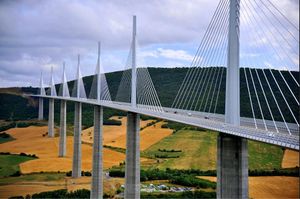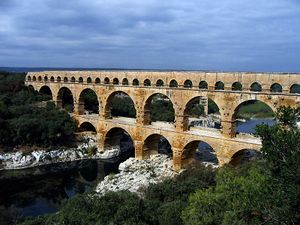Looking at Bridges: Difference between revisions
From DT Online
No edit summary |
No edit summary |
||
| (3 intermediate revisions by the same user not shown) | |||
| Line 1: | Line 1: | ||
[[File:MillauBridge.jpg|300px|right|link= | [[File:MillauBridge.jpg|300px|right|The Millau Viaduct that spans the valley of the River Tarn near Millau in southern France.|link=http://en.wikipedia.org/wiki/Millau_Viaduct]] | ||
Most people may be surprised at the number and variety of bridges in their local area. Bridges tend to be taken for granted unless they are particularly spectacular ''(e.g. the [http://en.wikipedia.org/wiki/Humber_bridge '''Humber Bridge'''] or the [ | __TOC__ | ||
=====Introduction===== | |||
Most people may be surprised at the number and variety of bridges in their local area. Bridges tend to be taken for granted unless they are particularly spectacular ''(e.g. the [http://en.wikipedia.org/wiki/Humber_bridge '''Humber Bridge'''] or the [http://en.wikipedia.org/wiki/Millau_Viaduct '''Millau Viaduct'''])'' or they fail dramatically ''(e.g. [http://en.wikipedia.org/wiki/Tay_Rail_Bridge '''Tay Rail Bridge'''] or [http://en.wikipedia.org/wiki/Tacoma_Narrows_Bridge_%281940%29 '''Tacoma Narrows'''])''. | |||
All designers have to think of the job which needs to be done, the materials available and the shapes and forms which are possible. Each of these factors influences the others and the bridge designers' challenge is to find the right compromise. | All designers have to think of the job which needs to be done, the materials available and the shapes and forms which are possible. Each of these factors influences the others and the bridge designers' challenge is to find the right compromise. | ||
=====Features and Applications===== | |||
The job, or purpose, of structures like bridges and tunnels is to allow all the load placed on them safely to flow through and down to the ground. They must stay rigid and not wobble about. They must allow space for the railway, road or canal and sometimes space underneath to allow ships, trains, vehicles, or animals to pass through. | The job, or purpose, of structures like bridges and tunnels is to allow all the load placed on them safely to flow through and down to the ground. They must stay rigid and not wobble about. They must allow space for the railway, road or canal and sometimes space underneath to allow ships, trains, vehicles, or animals to pass through. | ||
---- | ---- | ||
<span style="color: blue">''' | <span style="color: blue">'''Activities:'''</span> | ||
Visit bridges in your local area and do the tasks: '''[[Asking About Bridges]]''' and '''[[Collecting Pictures of Bridges]]''' to find out enough about them to catalogue them and perhaps enter them into the DT Online [http://www.dtonline.org/structures/ '''Structures Gallery''']. | *<span style="color: blue">Visit bridges in your local area and do the tasks: '''[[Asking About Bridges]]''' and '''[[Collecting Pictures of Bridges]]''' to find out enough about them to catalogue them and perhaps enter them into the DT Online [http://www.dtonline.org/structures/ '''Structures Gallery'''].</span> | ||
</span> | *<span style="color: blue">Make a list of all the materials the bridges you have seen are made from. Some of these materials will be good at resisting '''[[Compression]]''', some '''[[Tension]]''' and some both. Devise some tests to discover which is which.</span> | ||
*<span style="color: blue">Some materials may be cheaper than others, more readily obtainable or easier to work with. Draw up a table to show the advantages and disadvantages of each material for different '''[[Common Bridge Types|types of bridge]]'''.</span> | |||
---- | ---- | ||
The great variety of structures and styles of bridges result from the choices the designer has had to make. The use and location of the bridge has had to be taken into account and the wide range of materials available has had to be considered - materials have individual properties which make some of them more suitable than others in a particular situation. | The great variety of structures and styles of bridges result from the choices the designer has had to make. The use and location of the bridge has had to be taken into account and the wide range of materials available has had to be considered - materials have individual properties which make some of them more suitable than others in a particular situation. | ||
| Line 18: | Line 27: | ||
[[File:PontduGard.jpg|300px|right|link=http://en.wikipedia.org/wiki/Pont_du_Gard]] | [[File:PontduGard.jpg|300px|right|Pont du Gard Bridge, Southern France|link=http://en.wikipedia.org/wiki/Pont_du_Gard]] | ||
The [http://en.wikipedia.org/wiki/Pont_du_Gard '''Pont du Gard'''] in France shows what was achieved by the Romans using this simple structure. | The [http://en.wikipedia.org/wiki/Pont_du_Gard '''Pont du Gard'''] in France shows what was achieved by the Romans using this simple structure. | ||
| Line 27: | Line 36: | ||
As new materials have become available, they have been exploited by bridge designers. Looking at bridges, old and new, can give some insight into how materials and construction methods have changed and also how the demands placed upon them have altered as industry and transport has developed. | As new materials have become available, they have been exploited by bridge designers. Looking at bridges, old and new, can give some insight into how materials and construction methods have changed and also how the demands placed upon them have altered as industry and transport has developed. | ||
{{Bridge Models Buyers Guide}} | |||
[[Category:Bridges]] | [[Category:Bridges]] | ||
Latest revision as of 18:32, 9 February 2021
Introduction
Most people may be surprised at the number and variety of bridges in their local area. Bridges tend to be taken for granted unless they are particularly spectacular (e.g. the Humber Bridge or the Millau Viaduct) or they fail dramatically (e.g. Tay Rail Bridge or Tacoma Narrows).
All designers have to think of the job which needs to be done, the materials available and the shapes and forms which are possible. Each of these factors influences the others and the bridge designers' challenge is to find the right compromise.
Features and Applications
The job, or purpose, of structures like bridges and tunnels is to allow all the load placed on them safely to flow through and down to the ground. They must stay rigid and not wobble about. They must allow space for the railway, road or canal and sometimes space underneath to allow ships, trains, vehicles, or animals to pass through.
Activities:
- Visit bridges in your local area and do the tasks: Asking About Bridges and Collecting Pictures of Bridges to find out enough about them to catalogue them and perhaps enter them into the DT Online Structures Gallery.
- Make a list of all the materials the bridges you have seen are made from. Some of these materials will be good at resisting Compression, some Tension and some both. Devise some tests to discover which is which.
- Some materials may be cheaper than others, more readily obtainable or easier to work with. Draw up a table to show the advantages and disadvantages of each material for different types of bridge.
The great variety of structures and styles of bridges result from the choices the designer has had to make. The use and location of the bridge has had to be taken into account and the wide range of materials available has had to be considered - materials have individual properties which make some of them more suitable than others in a particular situation.
Stone and brick, for example, are only good at carrying loads which press down on them - they are strong in compression. Stone and brick, like sticks of chalk, are not strong if they are bent - they are brittle materials. Bridge and tunnel designers, therefore, have to use structures which keep the stone and brick in compression. A suitable structure is an Arch.
The Pont du Gard in France shows what was achieved by the Romans using this simple structure.
Materials other than stone and brick make possible different ways of designing bridge type structures. There are only about four different bridge designs in total and the other three each need materials which have some bending strength and can resist being pulled apart - materials which are strong in tension. These materials tend also to be tough or resistant to shock, which is the opposite of brittle.
As new materials have become available, they have been exploited by bridge designers. Looking at bridges, old and new, can give some insight into how materials and construction methods have changed and also how the demands placed upon them have altered as industry and transport has developed.
|
Click top left to enlarge |










